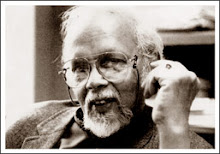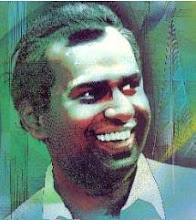Source: The Island
Date: 12/07/2008
As it is believed in government circles, the end to the war is just around the corner. That is, by defeating the LTTE military wing. If that reality comes about, it will force a paradigm shift in Sri Lankan politics by creating opportunities for Tamil people to rally around moderate leaders among themselves. The LTTE knows this, that is why it has been eliminating almost all moderate leaders within the Tamil community. In case of its military defeat, it does not want anybody to usher in a new era with a totally new kind of approach.
is, by defeating the LTTE military wing. If that reality comes about, it will force a paradigm shift in Sri Lankan politics by creating opportunities for Tamil people to rally around moderate leaders among themselves. The LTTE knows this, that is why it has been eliminating almost all moderate leaders within the Tamil community. In case of its military defeat, it does not want anybody to usher in a new era with a totally new kind of approach.
It does not want anybody to come up with new ideas, new angles of vision. So, if all the moderate and intellectual politicians among the Tamils could be killed, there will be a cultural wasteland which can assure the rise of LTTE- type ideologies. When the war enters its final phase the LTTE will accelerate killing moderate Tamil leaders hoping that next generation will also produce leaders no different from Prabhakaran. As Major General Sarath Fonseka recently argued, LTTE violence will continue as isolated and random attacks even after its ‘armed forces’ are totally destroyed. These isolated attacks will target moderate Tamil leaders while the LTTE buys time to regroup its armed forces.
What this means is that the cycle of violence is not going to end after t he capture of Kilinochchi. Can we in the South help Tamils to come up with a totally new kind of politics after the bloody era of the LTTE? Yes we can. But we have to learn to accept that the ‘totally new’ post-LTTE Tamil politics cannot be something dictated by us, in the South.
he capture of Kilinochchi. Can we in the South help Tamils to come up with a totally new kind of politics after the bloody era of the LTTE? Yes we can. But we have to learn to accept that the ‘totally new’ post-LTTE Tamil politics cannot be something dictated by us, in the South.
In order for us to usher in a new era, we must be dialogic––in the broadest sense of the word. May be it is little bit too early to talk of a post-LTTE era. Perhaps, it is better to be too soon rather than to be too late. Running the risk of being too wishful, I want to reflect on what the post-LTTE era would be like.For a post-LTTE era to be meaningful, we must be able to get rid of the very structures that created an organisation like the LTTE. We will be happy without Prabhakaran but we all will be happier without the economic, political and ideological structures that created a man like him. It is ironic that Buddhism, which is so good at explaining the violence hidden in what is taken to be ‘self’- both in a personal and cultural sense- has not been able to help us imagine a fundamentally new and peaceful Sri Lanka.
Perhaps, there is no better time for this kind of reflection than the month of July- the fatal month during which the South fell from grace 25 years ago. I was 14 then, old enough to remember how Tamil houses of my village were burning one morning. Yet, the burden on my conscience is bit less since no Tamil was killed in that village. Those people were wise, and they fled before the killers could get to them! And some of us saved the life of one man, whom we called "Master Mama." But one of the richest men in a group of villages, including ours ,lost his coconut and coir mills just because he was Tamil. Our villages, however, deserve some credit: that man could become ‘one of the richest’ among us in spite of being Tamil. Many Sinhala men and women worked for him. Some Sinhalese managed his business. Years later, when I visited the village which my family left in 1983, I could hardly recognise the place; Maheswari Stores of Ramayya mudalali once stood at Welipillewa, Digalla- about four miles north of Kuliyapitiya. By then Sinhalese businessmen had acquired uncle Ramayya’s property.
Ramayya was the first to bring a television set to our village. That was in 1980. He kindly allowed us village kids to watch the wonder that was TV in his large living room. Three years later, some men, perhaps the parents of those little TV-fans, broke into his house, not to watch the big TV but to take it away. Dr. Dayan Jayatilleka was correct in his great piece in Midweek Review, 09/07: to say that the culprits of '83 riots were government- sponsored thugs is self-deceiving. ‘Normal’ Sinhala Buddhists and Christians became goons overnight- may be just for a night. Ideologies do such things to people all over the world.
Our South, their North?
Our South can change the culture of their North by admitting that LTTE in part was produced by us. The discourse on conflict resolution has a useful expression: "structural violence." It is the violence built into or inherent in our societies and cultures. The ways we eat, live and do politics in the South could be predicated upon structures that create violence for others in other areas. Colombo-centered and Sinhala-centered political and economic structures are such that they marginalize many other areas irrespective of the ethnicities of the people in those parts. The problem of unequal distribution is not always ethnically defined. But it sometime is. Nearly fifty years ago, Franz Fanon and Aime Cesire(and others) showed us that the realities of a white worker and a black worker were not the same even if they both happen to be ‘workers’ in a same kind of factory. In a white-dominated world, a white worker can easily be ‘superior’ to a non-white one in most contexts. That kind of violence against non-white workers is built into the very structures of colonialism- an era Fanon and Cesire were writing about in their master works 'The Wretched of the Earth' and 'A Discourse on Colonialism'.
I am not claiming that Sri Lanka’s North is under direct colonial rule of the South. At the same time I cannot disclaim that the way the South behaves towards the North contains in itself a certain form of structural violence. Even after the war ends hopefully next year as our leaders predict, the structural violence will not cease to exist. It is a kind of violence which is difficult to see. To see it and to accept its existence one needs a great deal of cultural self-criticism. If not based upon such self-criticism no solution will be long lasting. This is something that teachers of engaged Buddhism ,such as Thich Nhat Hanh and Sulak Sivaraksa, have been arguing for years.
Self and self-criticism
Cultural self-criticism: well, we hardly do it these days. When the war ends in the North, and when we look into the long term future of post-LTTE Sri Lanka, the South also must be prepared to take a good look at itself. A society’s best opportunity for cultural reflection is provided by the art it creates. It is a mirror in which we look at our collective face. In our times, that mirror is literature, theatre and cinema. Last few years, we in the South did not like that mirror. In fact we hated it. We called our best filmmakers, "traitors." I have not seen all of those "anti-nationalistic" movies. But ones I saw, such as Prasanna Vithanage’s Purahanda Kaluwara, are modern classics of which the nation should be proud. Hopefully, when the war ends we will regain our sanity to see those great works of art as what they really are.
Rajitha Dissanayake’s new play Apahu Herenna Be (No Return), seems to ask us in the South to look back at ourselves. The play is set in a media monitoring centre- an arm of the state, controlling the flow of information: the centre decides what get transmitted as news and what is to be presented as "truth." Media truths are not free floating ones that are out there. They are truths manufactured and adorned by those who hold power. Therefore, mass media truths are often beautiful caskets in which to smuggle dominant ideologies. This is not something new. It happens everywhere, and it only grew into epic proportions with the origin of mass media. People like Noam Chomskey have written a good deal about this. The task of the true artist is to see through these ideologies and hold them at bay without letting them make the entire nation blind.
Sinhala artistes, however, hardly pay attention to how dominant truths are made and presented as the Truth.
Dissanayake’s play takes a peek behind the closed doors of institutions that make truths. It also attempts look into the inner lives of the makers of such truths. And the play becomes a microcosm of Sri Lanka’s South and its middle class life. While the entire South is embedded in bipolar discourse on war and peace, many middle class opportunists masquerade as saviours of the nation and make tons of quick cash. We all know how often the big chairs of state media are rearranged: they kill each other to be best to please their bosses by producing truths that make least harm to the status quo. In Dissanayake’s play a young intellectual, a PhD from an American university, comes home to serve the nation. He joins the media monitoring centre only to learn his intellectual ideals and integrity have no place there. When he tries to breathe some dignity into the centre he is called "Western", "anti-nationalist", "traitor", "pro-American", "NGO" and the like. In fact, Dissanayake shows us that those who call those names are the real traitors of the nation. Obsessed with the war and other popular rhetoric, the nation has no time to look back at itself. Great is the time for opportunists and they are after money, houses from government housing schemes, nice cars and, of course, women.
Dissanayake started out as ‘an artistic’ playwright valuing the aesthetic over the political and social. In his last couple of plays, he attempted to be an interventionist, and this play, No Return, is a severe indictment of Sri Lanka’s South and its inability for self- criticism. The play is not necessarily a critique of the state; it is a critique all of us in the South. When the war ends in the North, South needs to critically understand itself. In contrast to many recent Sinhala language novels, movies and dramas, which took to self-aggrandisement and self-veneration, No Return returns to true prowess of art. Its minor infelicities aside, Dissanayake’s new play, the sixth in his career, deserves our attention because it is timely and attempts to get all of us into a kind of critical mode which is essential when we reorganise ourselves in a post-LTTE and post-Sinhala supremacist world.
(The writer is a senior lecturer at the Department of Sinhala, Peradeniya University)



































No comments:
Post a Comment